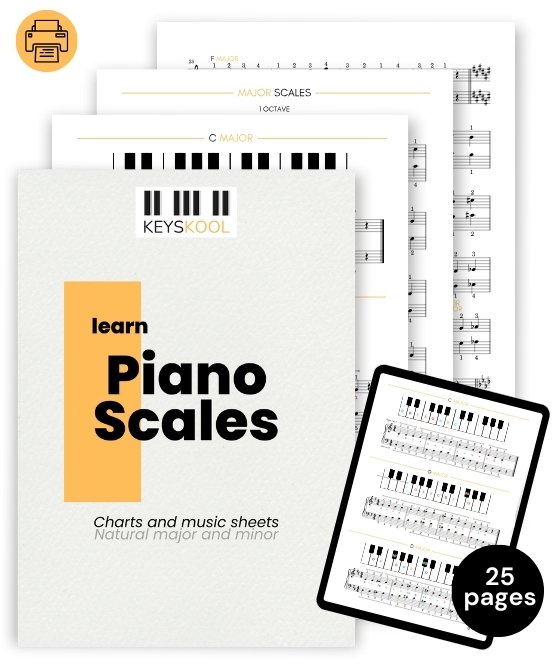Curious minds often wonder, “How many piano scales are there?” The answer?
COUNTLESS!
From the familiar major and minor scales to exotic, world-inspired melodies, the piano’s possibilities are infinite. Each scale paints a unique musical picture.
Let’s explore the most common scales
Without wanting to scare you, Here is a list of some commonly encountered piano scales:
Major Scale
Natural Minor Scale
Harmonic Minor Scale
Melodic Minor Scale
Blues Scale
Pentatonic Major Scale
Pentatonic Minor Scale
Whole-Tone Scale
Diminished Scale
Augmented Scale
Dorian Mode
Phrygian Mode
Lydian Mode
Mixolydian Mode
Locrian Mode Ionian Mode Aeolian Mode Locrian Natural 6 Scale Phrygian Dominant Scale Double Harmonic Major Scale Hungarian Minor Scale Gypsy Scale Arabian Scale Enigmatic Scale Bebop Major Scale Bebop Dominant Scale Bebop Dorian Scale
Bebop Minor Scale Bebop Melodic Minor Scale Bebop Harmonic Minor Scale Neapolitan Major Scale Neapolitan Minor Scale Eight Tone Spanish Scale Prometheus Scale Bluesy Scale Composite Blues Scale Major Bebop Scale Minor Bebop Scale In Sen Scale Bhairav Scale
Wait, don’t go away!
This list provides an overview, but there are many more scales and modes to explore, each contributing unique flavors to the world of music.
But you know what ? Do don’t need to learn them all

Essential piano beginner scales: Major vs. minor piano scales
As you begin your piano journey, understanding the fundamentals is key.
Scales are like the musical alphabet, laying the groundwork for all musical composition from classical to jazz to pop.
Can you believe that there are more than 200 types of scales out there!
There many types of scales from basic to exotic, but for those starting their piano journey, focus on the major and natural minor scales is the priority.
Major Scales:
The major scale, with its bright and joyful sound, is a must-learn for beginners. It forms the basis of many popular tunes and opens the door to musical exploration.
Major scale with no sharp or flat:
C Major Scale: C – D – E – F – G – A – B – C
Major scales with sharps:
G Major Scale: G – A – B – C – D – E – F♯ – G
D Major Scale: D – E – F♯ – G – A – B – C♯ – D
A Major Scale: A – B – C♯ – D – E – F♯ – G♯ – A
E Major Scale: E – F♯ – G♯ – A – B – C♯ – D♯ – E
Major scales with flats:
F Major Scale: F – G – A – B♭ – C – D – E – F
B Flat Major Scale: B♭ – C – D – E♭ – F – G – A – B♭
E Flat Major Scale: E♭ – F – G – A♭ – B♭ – C – D – E♭
A Flat Major Scale: A♭ – B♭ – C – D♭ – E♭ – F – G – A♭
The Natural Minor Scale:
The natural minor scale offer a touch of melancholy. Learning these scales complements the major scale, providing a balanced palette for expressing different emotions in your music.
Natural minor scale with no sharp or flat:
A Minor Scale: A – B – C – D – E – F – G – A
Natural minor scales with sharps:
E Minor Scale: E – F♯ – G – A – B – C – D – E
B Minor Scale: B – C♯ – D – E – F♯ – G – A – B
F Sharp Minor Scale: F♯ – G♯ – A – B – C♯ – D – E – F♯
C Sharp Minor Scale: C♯ – D♯ – E – F♯ – G♯ – A – B – C♯
Printable Practice Piano Scales PDF
With our piano scales guide designed specifically for beginners, you will master the most common and basics scales quickly and with fun.

Remember, you’re not just learning scales – you’re unlocking the potential to create beautiful melodies. Take it one step at a time, enjoy the process, and let the music guide you on your independent piano learning journey.

How Many Scales do Beginners Really Need to learn?
As you begin your piano journey, the question often arises: “How many piano scales are there?”
The quantity of scales may indeed seems overwhelming, but for beginners, simplicity is key.
The good news? You don’t need to conquer them all at once.
Quality Over Quantity:
In the early stages of learning, focus on quality over quantity. Rather than trying to master every scale, prioritize a few essentials. Start with the basics, again major and natural minor scales.
Building a Strong Foundation:
These fundamental scales lay a sturdy foundation for your musical journey. By mastering a select few, you build confidence and a deeper understanding of the piano’s language.
Practicality in Practice:
Remember, it’s about practicality. You’ll find joy and progress by delving into a manageable number of scales. Quality practice with a few scales is far more beneficial than spreading yourself thin.
This is YOUR journey
So, as you sit at the piano, take a deep breath. Enjoy the simplicity of your chosen scales. In the world of piano playing, less can truly be more. Happy playing! 🎹✨
Read : Music Modes: Major and Minor Modal Scales in Music Theory
Piano tips for beginners for Efficient Piano Practice
Don’t overwhelm yourself; simplicity is your friend here.
- Begin by practicing hands separately, gradually combining them.
- Use a metronome to maintain a steady pace – slow and steady wins the race in the world of scales.
- Pay attention to hand positioning; they’re like workouts for your musical muscles. your fingers should dance effortlessly on the keys.
- REALLY release any tension in your fingers, arms, shoulders, neck and bran 😀
- Consistency is the key. Practice your scales daily, even if it’s just for a short time. It’s the small, regular efforts that lead to significant progress. 5 minutes to start your practice is the best warm up.
- Embrace memorization. Visualize the patterns on the keyboard; it’ll make scales feel like familiar paths rather than daunting challenges.
Easy Songs with Basic Major and Minor Scales
Discover the joy of playing by exploring easy songs. These tunes are your companions on the beginner’s path, embracing simplicity and motivation.
Here are 8 songs for beginners, embracing the simplicity of basic major and minor scales.
“Twinkle, Twinkle, Little Star”
A timeless classic that dances along the major scale
“Mary Had a Little Lamb”
The familiar tune of this nursery rhyme, traversing both major and minor scales.
“Chopsticks”
A playful and easy piece that introduces beginners to simple hand coordination.
“Jingle Bells”
A cheerful tune in the major scale.
“Ode to Joy”
Beethoven’s masterpiece, simplified for beginners, using the major scale.
“A Thousand Years” (Christina Perri)
A pop ballad, employing both major and minor scales.
“Can’t Help Falling in Love” (Elvis Presley)
Embrace the romantic notes of this classic with the magic of the major scale.
“Someone You Loved” (Lewis Capaldi)
A gentle exploration of major and minor harmonies.

This is YOUR journey! You got it!
Most importantly, enjoy the journey. Learning piano scales is not a race; it’s a delightful exploration of musical possibilities. So, grab a seat, let your fingers dance, and savor every note. 🎹✨
